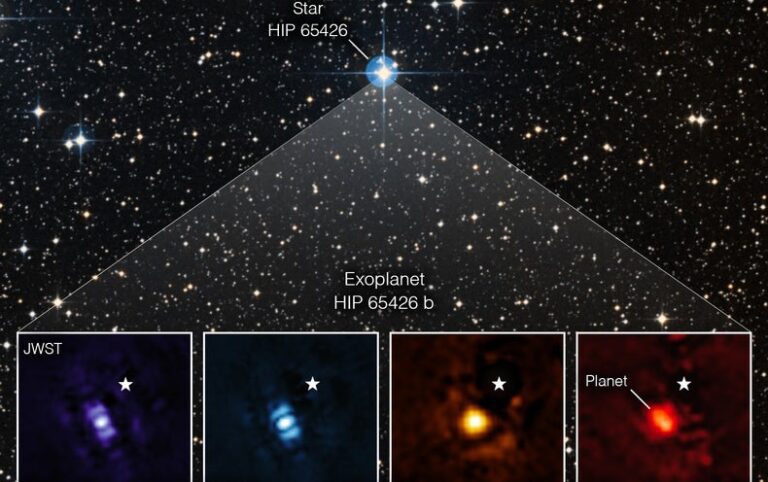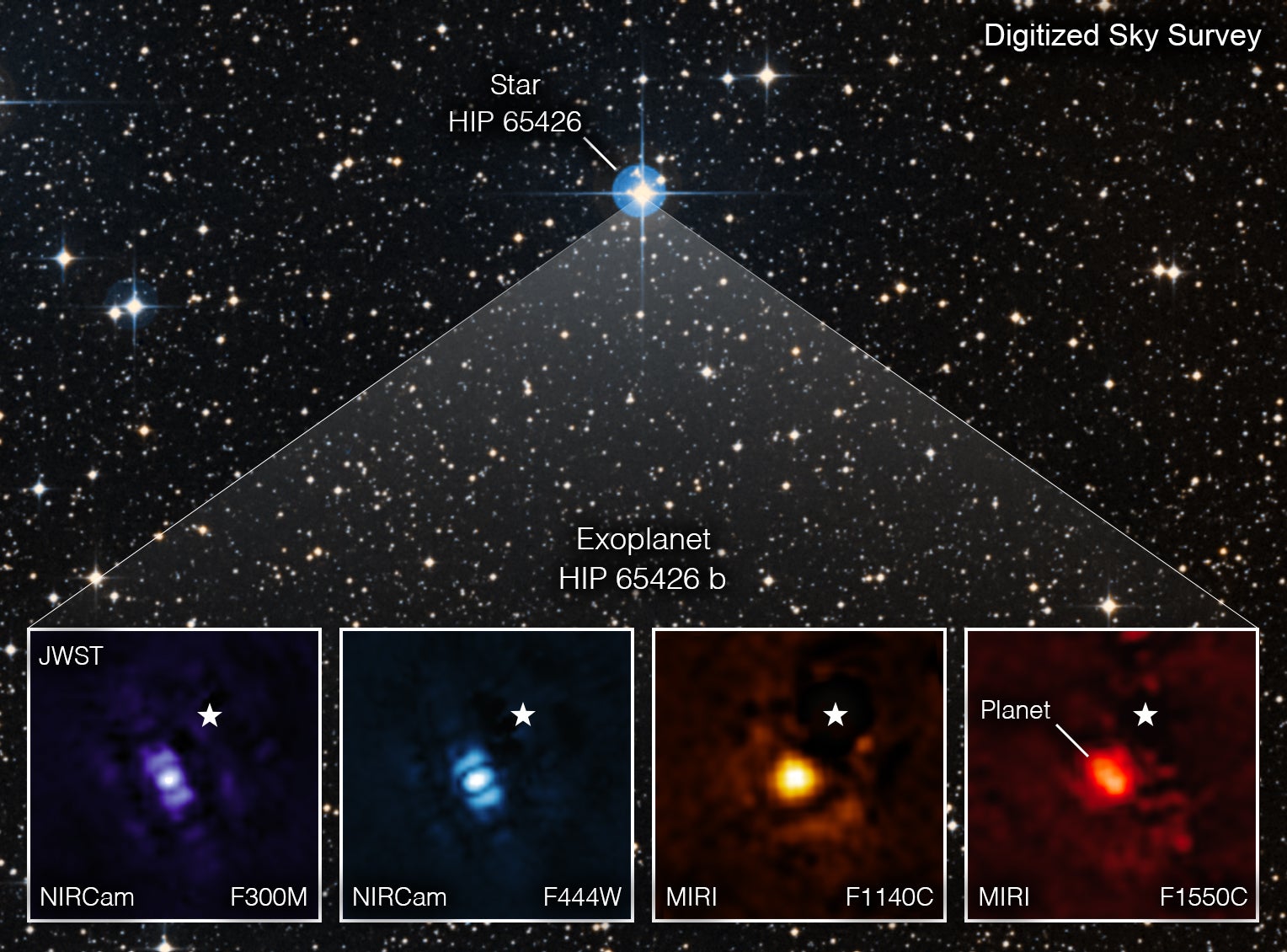
[ad_1]

The James Webb Space Telescope (JWST) has taken its first direct images of a planet orbiting a distant star. The planet, known as HIP 65426 b, is a gas giant several times more massive than Jupiter, circling its star at a distance that is about three times greater than the separation between Neptune and our sun. HIP 65426 b is only around 15 million years old—a newborn in astronomical terms—and roughly 350 light-years from Earth.
You might not be impressed by the level of detail in these new planetary photographs, but the researchers who took the images certainly were. When the results came back, “I had to make sure that I wasn’t looking at a simulated image,” says Sasha Hinkley, a professor of astrophysics at the University of Exeter in England, who helped lead the study. “It looked like the model images from when we wrote our proposal five years ago.”
The images of HIP 65426 b reveal that JWST is outperforming expectations for its exoplanet studies, which are one of the telescope’s four central research areas. This means that JWST’s scheduled attempts to observe other exoplanets will likely be even more successful than researchers had hoped and that astronomers can get even more ambitious when submitting proposals to JWST’s governing board in future research cycles.
JWST is not the first telescope to take direct photographs of exoplanets, but it’s already proving to be the best. Hinkley has seen the field evolve: he’s been working on exoplanet imaging for almost 20 years. “I was really intrigued by the technical challenges of this research—of having to block out these incredibly bright host stars, which are 10,000 or a million times brighter than the faint planets orbiting them,” he says.
Such a feat almost sounds impossible—like spotting a dimly glowing firefly fluttering under a bright stadium light from your seat across the field. And yet with the right technique, exoplanets can be revealed.
“We can go and observe a star that’s nearby that has similar properties to the target star,” says study co-author Aarynn Carter, a postdoctoral researcher at the University of California, Santa Cruz, who led the analysis for this exoplanet imaging. “Then we can essentially build up a template of what the starlight looks like and subtract that away to leave behind just the planet.”
That sounds deceptively simple, but a lot of things need to go right for this method to succeed. And in this case, they did go right—even more so than Carter and Hinkley had planned.
JWST’s imaging sensitivity turned out to be even greater than anticipated. Its advanced coronagraph succeeded at blocking out a majority of the host star’s light. And perhaps most importantly for this particular study, JWST held incredibly stable when taking its observations. Stability is crucial to obtain a clean starlight template from a second star to subtract from the first.
“What we saw is that James Webb is so incredibly stable that the [starlight] pattern is therefore stable from star to star,” Hinkley says. “And this is really due to the incredible work that has been done by literally thousands of scientists and technicians and engineers over the last 20 years across the entire globe.”
Charles Beichman, director of NASA’s Exoplanet Science Institute, helped develop the JWST research instruments that Hinkley and Carter used in their imaging. “When you launch something,” he says, “you build it to a set of requirements. And then you have a set of what we call ‘desirements.’”
Thanks to the latest exoplanet images, it’s now clear that JWST’s instruments are fulfilling everyone’s desirements. “You’ve got tighter images; you’ve got less jitter; the detectors are performing a bit better,” Beichman says. Because of its proved level of sensitivity and stability, JWST has the potential to directly observe much smaller exoplanets than any other telescope has in the past—even smaller than researchers had hoped.
That’s excellent news for future studies, including one that will be led by Beichman between July and August 2023 that will use direct imaging to look for planets within our nearest star system, Alpha Centauri.
So far astronomers have only managed to photograph exoplanets that are several times larger than Jupiter and orbiting very far from their stars. “But what we now know from these observations is that James Webb is probably going to get us down to analogues of our own Saturn or maybe our own Neptune for the closest stars,” Hinkley says.
Sebastian Marino, an astronomy research fellow at Jesus College at the University of Cambridge, is one likely beneficiary of JWST’s expectation-shattering overperformance. Between next April and June Marino and his colleagues plan to observe stars that are surrounded by wide debris disks that resemble gargantuan versions of Saturn’s rings. Marino’s team will focus on a few particular disks that have noticeable gaps, working under the hypothesis that as-yet-undetected exoplanets are responsible for “carving” these gaps as they orbit their host stars.
Based on the width of the gaps, Marino predicts that these exoplanets (if they exist) are around the same mass as Saturn or Neptune. While detecting them started out as an ambitious goal, the latest imaging results indicate that JWST is capable of detecting planets at those very sizes, as Hinkley notes.
“The fact that it’s performing better than we thought is really encouraging,” Marino says. And even if JWST doesn’t find the exoplanets he’s hoping for, Marino is glad that the telescope will be able to confirm those planets don’t exist. (An important but oft-overlooked aspect of planet hunting is knowing when to stop looking for worlds around any given star.) A weaker telescope, Marino says, would be far more likely to yield inconclusive results that only extend what could be an ultimately fruitless search.
The latest exoplanet images also bode well for Elisabeth Matthews, a postdoctoral researcher at the University of Geneva. “For my own program, it’s validating to see that the instrument really will work as well as we expected when we designed the program,” Matthews says.
Between April and May 2023 Matthews will use JWST to observe a nearby planet-bearing star—Epsilon Indi A, only 12 light-years away. That star’s exoplanet, Epsilon Indi Ab, is known only through the subtle gravitational wobble its bulk induces on the star. No one has ever directly seen this planet, but astronomers’ best estimates suggest it must be fairly cold, which means it’s fairly old. Giant exoplanets are thought to be born hot, radiating immense amounts of residual heat energy from their recent creation. (The glowing planetary blob seen in JWST’s infrared images of HIP 65426 b is mostly thermal energy emitted by the planet itself, not light that’s reflecting off the tops of its clouds.)
Older, colder planets have generally been too faint to photograph—drowned out by the bright light of their host stars. Thus, Matthews’s plan to image a more mature planet is challenging, but JWST’s recent performance suggests that it should certainly be possible. Matthews says she designed her study to take up the minimum amount of time needed to be able to produce a planetary image—but now she’s even more confident that it will succeed in that time frame because JWST’s greater-than-expected sensitivity is akin to being granted more observing time.
It’s too late to easily change plans for JWST’s inaugural “Cycle 1” observations to capitalize on its greater-than-anticipated high-contrast imaging performance, but these early results will certainly make astronomers more confident when planning future research. Both Marino and Matthews suggest that they might set bolder research targets next time around. Research proposals for JWST’s second cycle of observations will be due in late January.
Before then Sasha Hinkley plans to reach out to the astronomical community with advice on how to get the most out of JWST based on his team’s updated understanding of its capabilities. “We expect that our recommendations will enable the community to put forth the strongest possible set of proposals to make these observations,” Hinkley says.
In future research cycles, targets that were considered too small or distant to observe might be considered in reach. And ultimately JWST’s superlative exoplanet imaging work should help guide efforts to develop even more ambitious observatories that can photograph not just gas giants but targets that are much smaller and fainter: potentially habitable, more Earth-like worlds.
“Proposals that were ‘Wow, it’ll be lucky if we can do that’ come into the realm of ‘Yeah, we should be able to do that,’” Beichman says. “And a new set of things that were ‘There’s no way we could do that’ enter the realm of ‘Yeah, we’ve got a shot at pulling that off.’”
[ad_2]